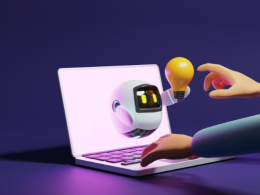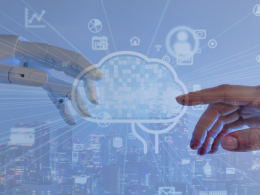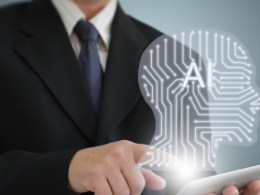After surviving the AI winter in the late 1980s and 1990s, Artificial Intelligence has resurfaced and this time, it is all the buzz. It can be overwhelming trying to understand how things work in AI, how can you begin your stint in the field and what future, if any, does it have!
What is Artificial Intelligence?
Artificial Intelligence is the ability of a computer to take cognitive decisions by itself which otherwise would require human judgment. One could also call it the ability to replicate and implement rational thought processes as applicable to various situations.
Scientists have toyed with the idea of a sentient machine (a machine which emulates human ability to think and process in every aspect, including emotions) for quite long now. Alan Turing formulated the Turing Test as early as 1950. Till date, it is among the most trusted tests for judging the intelligence of a machine.
Why is it Important?
The answer in a simple line would be: because it is the future.
When we talk about the future of human society, artificial intelligence is one factor that would shape it immensely. We will use more AI-based products, even real AI will become a common thing in, say seventy years from today. The extent of its intelligence might or might not exceed our current expectation but its presence is quite assured.
Hence in future, when we use AI that seamlessly, we will also need resources to support that. This would mean more AI programmers, better algorithm developers, stronger frameworks and better performance and results.
Applications of AI
Under AI, researchers try to build machines which can display a decision-making capacity rivaling that of a human brain. Different aspects involved in decision-making have thus been put under separate sections. We will now discuss these sections one by one:
1. Reasoning and Problem Solving
When we think, we use intuitive judgment to reach a decision. Computers, on the other hand, began as a step-by-step processing system, making decisions through executing a certain set of instructions.
However, AI started using concepts from probability and economics to deal with uncertain or incomplete information by the late 1980s and 1990s.
Using these techniques for more difficult problems resulted in the need of colossal computational resources as most solutions led to ‘combinatorial explosions’ (too many combinations). It necessitated developing rather efficient storage and computational power options.
We did improve a lot in both of these fields but still, for a problem of certain size, resources required can become astronomical. Hence, we focus on developing efficient and less resource intensive solutions and algorithms.
2. Knowledge Representation
AI systems are expected to solve complex problems which in turn require extensive databases. An AI system needs to represent objects, properties, situations, events, states, time, categories and relations between objects in a way that it can easily utilize and retrieve.
An existing representation is called an ontology. Domain ontologies cover specific information about a domain whereas upper ontologies provide links between these domain ontologies.
The most difficult issues in knowledge representation are, Default Reasoning and the quantification problem, the breadth of commonsense Knowledge, and subsymbolic form of Commonsense knowledge.
3. Planning
What does Planning mean to a Narrow AI system?
When intelligent systems solve a problem, they have a stage they begin at and a stage which they are to reach. Ideally, a system assumes it is the only system function at the time or trying to reach the goal. This allows the system to be certain results its actions will bring about.
The AI of future, however, will not be functioning in isolation, systems will interact more often than not. In this case, how a system decides the apt course of action will be an important issue. Systems will have to:
- learn to differentiate between other systems
- process requests from systems as well as humans.
- Prioritization of requests will also be an ethical and pragmatic issue in these situations.
4. Learning
Learning happens mainly in two ways, through supervised learning (pattern recognition) and unsupervised learning (regression and classification). Unsupervised learning has recently gained a boost with neural networks and deep learning. In future, real-time learning and adaptiveness would be the real judge of an AI system’s efficiency.
5. Natural Language Processing
Understanding spoken commands has become relatively easy with recent advances in deep learning and unsupervised learning. However, computers are not yet fully capable of generating sensible sentences. In future, we aspire for machines which can seamlessly understand and convey answers to users. Further research in this field is focussed on understanding semantics better and helping the computer learn the same.
6. Motion and Manipulation
To handle tasks like object manipulation and navigation, Robots need extensive support from AI. It requires not only a strong object detection algorithms, but also an enormous processing computing power.
Social and General Intelligence, creativity, perceptions are other important areas where research is still underway in AI. The cumulative growth in these areas will shape the future of AI.
Future of AI
Artificial intelligence has stimulated human interest for quite long now. After the end of the AI winter in the late 1990s, AI has been garnering interest from all sections of the society. Currently, AI is seeing a high tide of substantial innovation and real-life application.
Most major organizations across sectors have implemented AI solutions to automate, improve or streamline their performance and to cut overheads. AI systems bring in precision and predictability against manual systems and are thereby preferred.
While it is exciting, we need to demarcate fields where and what kind of AI might be implemented. The threats and issues which AI could pose have been discussed at the end of this article.
Career Scope in AI
Thanks to the rising interest in machine learning, AI is getting a new life. With powerful concepts like neural networks and deep learning, improved regression algorithms and humongous amounts of data from IoT and big data frameworks, AI has achieved a stabilized position from where the demand goes only upwards.
AI is automating some traditional jobs and is creating some new ones just like every other technological revolution has. The advancing profiles under AI are:
1. Data Scientist
The Job Role?
A data scientist is and will continue to be among the most coveted people in the AI field. Data Scientists are people who conjoin big data and machine learning algorithms to lead to an intelligent framework. A data scientist not only organizes, processes and analyzes data but also makes sure that the corresponding algorithm can process it. In case of poor performance or erroneous predictions, a data scientist notifies the developers about required changes and upgrades.
The Required Skill Set?
To be a data scientist, you should be proficient in R or Python, a querying language like SQL, basics of statistics, multivariable calculus and algebra.
If the company you are interviewing at handles humongous amounts of data or the product itself is data-driven, you’d do good to have a good grasp of basics of machine learning algorithms like k-nearest neighbours, random forest, ensemble methods and neural networks.
A Blanket Title?
It might seem like data scientist is a blanket title covering various jobs (which it truly is). However, you need to understand the current market scenario in this context. Right now, patterns and roles are being defined in AI, employees of today and of many years to come, will need to be multi-taskers. Moreover, once you get a hang of it, this job is quite rewarding.
2. Machine Learning (ML) Engineer
The Job role?
A machine learning engineer develops and tests the software which becomes the main framework of an intelligent system. Machine Learning engineer also deals with data sets. When feeding data to the system, the data needs to be in a suitable format. Organizing data in this format falls upon the ML engineer.
The Skill set?
To become an ML engineer, it pays to have a good understanding of machine learning concepts, multivariable calculus, statistical analysis (while judging the goodness of performance matrices and the program’s results) and R/Python. Knowledge of Java or another programming language also helps.
Neural Networks Engineer
3. Neural Networks Engineer
The Job Role?
A neural networks engineer is essentially a machine learning engineer specializing in deep learning methods and neural networks. Their job might be as diverse as developing a futuristic neural system framework or designing an intelligent prosthetic limb’s actions.
Neural systems are?
Neural networks are computing systems used to build software that learns instead of storing values of data. That is, it doesn’t store a variable’s state or detail but attaches an importance number like figure to it, which is used by activation functions stored in each node of the network. The activation function turns on or off depending on this value and decides the end result as the input is processed by the last node.
The Required Skill Set?
The basic skill set that one needs to be a neural networks engineer would be proficiency in using R (for statistics oriented programs) or Python (predictive systems) in algorithms and data structure and good grasp of basic statistical concepts and multivariable calculus.
The work opportunities in this field are plenty considering that the talent pool is way smaller than the demand. The demand for ML engineers will only spiral up in future.
4. Big Data Analyst
The Job Role?
Data analysis is a separate field and the job of a big data analyst is largely similar to that of a general data analyst. However, all the data that is used to train the artificially intelligent systems comes from big data analysis. These analysts need to work with elephantine amounts of raw data and process it into usable and organized data.
For training algorithms, we need this structured data. In natural language processing, speech recognition, back-office automation etc the contribution of big data is commendable, all thanks to the big data analysts.
The Required Skill Set?
The skill set that one needs to become a big data analyst can prove quite exhaustive and might confuse you.
If you are just beginning, we would advise that you begin with Hadoop-Spark and move into real-time data analysis using Storm-Kafka and NoSQL databases. If you plan on migrating towards Machine Learning here on, you could do that by mastering Python-Spark.
If you have some prior experience in analytics, particularly with tools like SAS/R, you could start with exploring data science using R and gradually advance to SPARK, Python and data science using machine learning.
5. Roboticist
The Job Role?
A roboticist is a person working in the field of robotics, designing hardware or software of these coveted machines.
Robotics is a field most commonly conjoined with AI. While the advent of robotics was due to the need of automation, intense robotics research is being focused at advancement in estimation theory, mobility mechanisms, active computer vision, natural language interfaces, multi-agent negotiation, machine learning, probabilistic language models for use in spoken language interfaces, and the modeling and integration of visual, auditory, haptic and motor information.
In combination with AI, robotics will be able to formulate real-life solutions in fields like medicine, healthcare, automotives etc. The demand and supply gap is astounding in the overlapping area of these two fields.
The Required Skill Set?
For the naive, a graduate degree in robotics will prove quite useful. If you choose to work with machine learning (AI basically), you can go for a course in R/Python and there on to machine learning from a university or online from websites like coursera.com, udemy.com etc.
Learning AI Programming
Online or Offline?
We have various sources both online and offline which assist your initiation in AI.
If you are willing to pursue a degree or post-graduation course in Artificial Intelligence, various universities like Stanford, UIT Texas, MIT etc offer courses in AI.
For those who are already in IT and are looking for online resources, we would recommend Udacity, coursera and Udemy. These websites offer excellent courses at minimal charges and you can take your classes at your own comfort. Our top recommendation will be the Coursera nanodegree course as it includes a significant amount of hands-on practice.
Before You Begin
Before joining any AI course, a clear vision of which subfield of AI you wish to join and which kind of position you are looking at, will be helpful. It will save your time and will help in streamlining your efforts.
Joining competitions at sites like kegel, will help you hone your programming and development skills along with making you proficient at procedures that you’ll be following while dealing with real-life problem modelling and solutions.
AI Use Cases
From our smartphones, tablets, bank and to our house and cars, we use AI everyday. Sometimes it stands out and sometimes it’s hardly even visible. For example, when we ask Siri for directions to the nearest mall or Alexa to turn up the volume of music, we are using the obvious AI.However, when a website recommends you certain products or you keep seeing certain ads at all websites using adsense, this is the hidden AI we mentioned.
1. Healthcare
Along with automating the existing procedure, providing a more capable and accurate system of measuring dosages and diagnosis and analyzing medical reports, Artificial Intelligence has resulted in the rise of a revolutionary field, precision medicine. Here, AI is used to study, diagnose and prescribe medicines; all tailored to the requirements of the patient in question.
2. Automotive
Automobile or automotive Industry is huge and also has a high percentage of jobs which are repetitive and automatable. Leveraging this fact, AI is being used to automate systems which could not be mechanized earlier.
3. Finance and Economics
If there could be one sector happiest for the advent of AI, it will definitely be the Finance and Economics world.
Purchase Prediction: With AI, enormous amounts of data are studied and patterns predicting purchase potential based on a number of factors emerge. These patterns are quite helpful in streamlining ad campaigns, product placement at supermarts, revenue prediction and inventory management.
4. Fraud Detection
Financial institutions use intelligent systems to detect unusual transactions and possible frauds within the systems and warn the users about it.
5. Recommendation AI
Most e-commerce websites ranging from Amazon to Netflix, use AI algorithms to study the pattern of a user’s choice of products and accordingly recommend products that the user might like.
6. Customer Segmentation
Instead of the traditional methods of segmentation, today’s artificially enabled algorithms can study diverse sets of data, perform extensive analysis and predict potential customer base.
7. Video Games
In video games, AI is used to support intelligent, responsive and adaptive behavior in non-player characters of the game, similar to human intelligence in similar real-life situations. This lends a real-life touch to the video game, enhancing the user experience. AI is also used for user data mining, customization according to user selections, dynamic game difficulty balancing, procedural content generation and much more.
8. Education
AI is used to develop virtual mentors (like the Intelligent Tutor Systems mentor, which can track mental steps a person takes while learning and correct them where they are faltering), analysis of interaction data and in extending learning outside the classroom through life-size learning models.
9. IoT
AI’s true potential is put to use in the field of IoT. you might even say that IoT won’t work without AI. IoT produced colossal amounts of data which when used diligently can improve our lives significantly. This processing and analysis is what AI systems do (albeit with help of Machine Learning , which is emerging as an important sub field of AI). We are advancing towards a future IoT is commonplace like mobile phones today and AI will equip us to make the best use of it.
10. News Generation
AI is not yet advanced enough to write well researched and complex articles but simple articles which require lesser synthesis like financial summaries, sports recaps and fantasy sports reports are not a big deal for it. As of now, news geenarting AI systems need quite some help from the human author but with advancements as they are happening, it’s only a matter of time before we see fully automated news.
11. Surveillance
A certain number of security personnel surveilling a building or arena are still prone to various loopholes like bias, corruption or may be negligence. On the other hand, AI-powered systems steer clear of these issues and can monitor higher number of feeds at the same time.
Potential Threats of AI
1. Existential Risk
Existential risk is a theory that propounded the idea that one day AI might get so advanced that it would result in human extinction or some other global catastrophe that would be irreversible. The logic here is that AI can recursively improve its own algorithm if it learns how and can thereby become superintelligent at an exponential rate. It might become impossible to control and become a threat to the human race.
While it sounds like a real threat, this dystopian theory depends highly on how various fields of intelligent systems grow. A sudden outburst of intelligence may take the human race by surprise but assuming that it would be catastrophic might be going a bit too far.
2. Devaluation of Humanity
Supporters of Computationalism claim that an artificial machine even as it is emulating, is not really feeling the emotions and empathy it displays. Hence, employing AI-powered devices in sectors like hospitality, healthcare and judicial systems will be devaluing human dignity and human values as machines lack the basic human traits.
Weizenbaum, the propounder of this idea, was also bothered by the fact that many AI philosophers and developers were ready to see human mind as nothing more than a special computer.
3. Looming Danger of Unemployment
The increase in automation and replacement of human labor by AI-powered machines might lead to widespread unemployment. Professionals like telecallers, marketing teams, even drivers might see a loss in demand for human resource due to advanced AI-machines coming to fore.
However, we would do good to remember that AI is also bringing a boost to other jobs. Specialised skills like programming, analysis, deep learning, machine learning etc are flooded with work opportunities with limited talent supply.
It could therefore be said that there will definitely be a paradigm change in which jobs human do but work opportunities will always be however in fields not exactly traditional.
4. Artificial Moral Agents
Discussed first by Wallach, Artificial Moral agents or AMAs will be intelligent machines which will make moral decisions. The heart of matter here is, how should these machines behave towards humans and other machines and should machines be making moral decisions in the first place?
AMAs can reflect both positively and negatively on our society. They could be good judges and unbiased facilitators. If misused, that is powered with a faulty or biased logic, AMAs can prove fatal or quite damaging at least.
Machine Ethics
The idea of autonomous intelligent machines without any ethics has given rise to an intense debate on the subject. Such machines can be fatal and catastrophical if they spiral out of hand.
The field dealing with machine ethics, focuses on giving machines a way to solve ethical dilemmas they might face while at work so that they can become ethically responsible for their acts.
This is a field requiring much discussion as debating machine ethics might bring forwards some issues in our ethical theories, advancing our ethical theories of today.
Malevolent and Friendly AI
Physicist Stephen Hawking, SpaceX founder Elon Musk and Microsoft founder Bill Gates, amongst others, have expressed concerns that just because we can’t think of a reason as to why machines will turn on humans doesn’t mean that they will not. Mr. Hawking has gone as far as saying that humans will bring upon their extinction through AI.
Charles T. Rubin has argued that “any sufficiently advanced benevolence may be indistinguishable from malevolence.”, that is, AI systems can neither be guaranteed or designed to be benevolent. There is no reason why a super intelligent system should support human existence.
While all these arguments hold water, we must also remember that the current AI advancement is at least a century away from building sentient voilitionary intelligence. We should not confuse the difference between the beginning of real AI and the complexity and enormity of building the sentient machine which could care about the supreme being or debate the worth of human existence.
Conclusion
AI is a growing field, it is touching more lives than ever and is changing them in one way or another. We indeed are at a technological turning point. However, we would have a good understanding of AI before lunging forward. If you are looking for a career in AI, there are many options. If you are looking forward to your own startup, AI has a plethora of functions you could choose from. All that you need to do is take your pick and go full-throttle at it.






